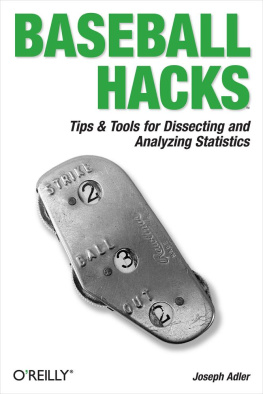Frederick E. Taylor - The Runmakers: A New Way to Rate Baseball Players
Here you can read online Frederick E. Taylor - The Runmakers: A New Way to Rate Baseball Players full text of the book (entire story) in english for free. Download pdf and epub, get meaning, cover and reviews about this ebook. year: 2011, publisher: Johns Hopkins University Press, genre: Home and family. Description of the work, (preface) as well as reviews are available. Best literature library LitArk.com created for fans of good reading and offers a wide selection of genres:
Romance novel
Science fiction
Adventure
Detective
Science
History
Home and family
Prose
Art
Politics
Computer
Non-fiction
Religion
Business
Children
Humor
Choose a favorite category and find really read worthwhile books. Enjoy immersion in the world of imagination, feel the emotions of the characters or learn something new for yourself, make an fascinating discovery.

- Book:The Runmakers: A New Way to Rate Baseball Players
- Author:
- Publisher:Johns Hopkins University Press
- Genre:
- Year:2011
- Rating:3 / 5
- Favourites:Add to favourites
- Your mark:
The Runmakers: A New Way to Rate Baseball Players: summary, description and annotation
We offer to read an annotation, description, summary or preface (depends on what the author of the book "The Runmakers: A New Way to Rate Baseball Players" wrote himself). If you haven't found the necessary information about the book — write in the comments, we will try to find it.
Statistics are the lifeblood of baseball. Managers pore over batting averages to determine game day lineups and batting orders; high number of runs batted in and low earned run averages receive praise from the press, higher salaries from the front office, and love from fans; and the fate of fantasy baseball players rises and falls with each statistical change. The prominence of the RC/27 and other more complex, formula-driven stats has made numbers even more important to understanding and appreciating the game. For all these baseball buffs and more, Frederick E. Taylor provides a new measure of hitting prowess that just might be a game changer.
Taylors potential runs per game (PRG) measure accounts for batters getting on base, advancing runners, and driving in runs, and it separates leadoff and second batters from those in the middle of the order. Taylor introduces the measure, explains how it works, and applies it to players past and present. He breaks the history of major league baseball into eight eras based on differences in runs scored per game. He systematicallyplayer-by-player and position-by-positioncompares the results of the PRG measure to those drawn from other statistics, such as on-base percentage and slugging average. Taylor shows that PRG is more accurate and that career clutch hitting is a myth.
Sabermetricians, baseball fans of all stripes, and anyone who earns a living from the sport will find a wealth of information and a whole new set of stats to obsess over in The Runmakers. Measuring baseball will never be the same.
Frederick E. Taylor: author's other books
Who wrote The Runmakers: A New Way to Rate Baseball Players? Find out the surname, the name of the author of the book and a list of all author's works by series.








